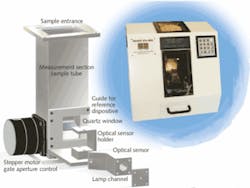SPECTROSCOPY: NIR method provides complex, rapid grain analysis

Companies storing or processing grain must rapidly determine its quality before directing an incoming load of wheat, and spectroscopy is often the answer.
TecnoCientifica (Buenos Aires, Argentina) tailors spectroscopic grain-analysis setups for customers that export grain or process raw materials to make vegetable oil, meal, and flour. Perhaps as important as time is the ability to determine multiple components, such as moisture and protein content of barley, or to analyze moisture, protein, and fat in soybeans.
Using miniature spectrometers and fiber optics from Ocean Optics (Dunedin, FL), engineers at TecnoCientifica design and build the systems, which include a sampling device, electronics, light source, optical sensor, automation, sensor controls, sensors, electronics and operational software.
Grain enters the top of a 10-in.-long aluminum tub. The sample falls through the tube at a speed regulated by a stepper motor, which controls the aperture of the exit gate to correlate with a specific grain. A laser designator ranger (LDR) detects the sample and signals the microcontroller to start the analysis.
A tungsten-halogen lamp is incorporated into an optical sensor that also contains a collimator lens and other components. The operator enters a sample ID corresponding to grain type, and then the instrument automates the process, giving the calibrated results when the sensor detects that the sample is out of the tube.
Basic and advanced
Two desktop models are available. The UltraNIR-WGA is designed for processing small grains such as barley, wheat, and rice. It is able to determine protein and moisture—parameters that are important for determining quality, storage capacity, process efficiency, and even market price.
The InLab NIR-Series system can determine concentrations of moisture, protein, fiber, starch, and fat in whole grains, meals, brands, pellets (ground), pet food, and animal feed. It is used for quality control in raw materials and end products, and process control of agricultural grain crops.
The InLab NIR-Series takes just eight seconds to analyze a sample, and “if you add information through the ‘more spectrum’ tool, the final process could take 20 seconds max, including the hopper filling procedure,” says Gustavo Caneda of TecnoCientifica. The UltraNIR-WGA can determine stabilized grain temperature in the hopper in 30 seconds.
In addition to desktop systems, inline systems enable real-time analysis of large volumes of material. “Practically, there is no limit in the quantity of the sample,” says Caneda. While TecnoCientifica’s customers are mainly in the grain and food markets, the systems can easily be applied to biofuels.
About the Author

Barbara Gefvert
Editor-in-Chief, BioOptics World (2008-2020)
Barbara G. Gefvert has been a science and technology editor and writer since 1987, and served as editor in chief on multiple publications, including Sensors magazine for nearly a decade.